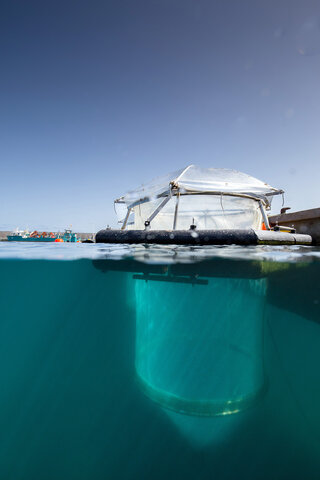
Output
EMB Future Science Brief No. 13 'Monitoring, Reporting and Verification for marine Carbon Dioxide Removal' (November 2025)
News article on the launch of the Future Science Brief (November 2025)
The EMB Future Science Brief No. 13 Monitoring, Reporting and Verification for marine Carbon Dioxide Removal was published on 17 November 2025, on a dedicated webinar. More information available here.
Background
Carbon Dioxide Removal (CDR) is defined as capturing CO2 from the atmosphere and storing it long-term, i.e. for decades to millennia. This storage can be on land, in the Ocean, in geological formations or in products. It can thus take many forms, from land and Ocean management practices such as forest or Blue Carbon ecosystem management and restoration, to technologies such as direct air capture, where chemical or physical processes are used to extract the CO2 directly from the air. To date, most CDR developments have been focused on land-based solutions. However, to achieve the required climate targets, novel CDR methods are required, including those linked to the Ocean.
Acknowledging the large oceanic carbon storage potential, marine CDR is currently being explored by publicly funded research and private start-ups. However, for marine CDR to be deployed responsibly more research is needed, and high-quality standards in terms of Monitoring, Reporting, and Verification (MRV) will be required. MRV is also crucial for ensuring that CDR activities generate the promised climate benefits and for the transparent regulation of a growing carbon removal market. Being able to accurately monitor, report, and verify the amount of carbon durably removed over time, and to measure the environmental effects of the marine CDR technology, is essential to evaluate the efficacy and effects of technologies being tested in controlled field trials and to assess if they are viable for future deployment at scale.
This working group provides input to the UN Decade of Ocean Science for Sustainable Development (2021-2030) societal outcome that aims for unlocking ocean-based solutions to climate change.
Working group objectives
The EMB Working Group on marine Carbon Dioxide Removal will focus on monitoring, reporting and verification (MRV) of these activities. The Future Science Brief should provide a state-of-the-art overview on the topic and conclude with relevant recommendations for policy and research funding. The document will be primarily written from a European perspective, but due to the global nature of marine CDR, it will have global relevance.
Specific topics that could be addressed in this document include (but are not limited to):
- Explaining the role of the Ocean in naturally absorbing and storing atmospheric CO2 and how this will change with different climate change scenarios;
- Outlining the amount of CDR needed to achieve climate objectives, current methods that are used or being developed, and the role that marine CDR can play;
- Providing an overview of the different methodologies for increasing marine CDR (through human intervention), including their potential for success, limitations and risks. This should include the degree of CO2 sequestration from the atmosphere that could be reached by the different methods, timescales to achieve long-term storage, environmental and social concerns and risks, and potential benefits of the different methods;
- Determining principles and research needs for reliable MRV, for deploying marine CDR methods at scale, and explaining the currently available methods, limitations, uncertainties and knowledge gaps for MRV of marine CDR, including the current and future potential to answer questions such as:
- Does the marine CDR activity generate a measurable reduction in the atmospheric CO2 concentration?
- To what extent can net additional Ocean uptake of atmospheric CO2 be tracked in response to the marine CDR activity using a combination of sensors, platforms, and models?
- How will the durability (permanence) of stored carbon be monitored?
- What are the impacts on marine ecosystems of marine CDR activities and how do they compare with the impacts of the no-action alternative or of other feasible climate mitigation measures?
- What are the range of impacts to human populations and how do they compare with the impacts of no-action or of other feasible mitigation measures?
The Terms of Reference of the EMB Working Group is available here.
Meetings
- 29-30 August 2024, kick-off meeting, Ostend, Belgium
- 11 October 2024, online
- 22 November 2024, online
- 14 January 2025, online
- 5 February 2025, online
- 11 August 2025, online
- 17 November 2025, launch webinar, online
Working Group Members
Chair: Helene Muri, NILU & Norwegian University of Science and Technology (NTNU), Norway
Co-Chair: Olivier Sulpis, CEREGE - Aix-Marseille University, CNRS, IRD, France
- Gabriela Argüello, University of Gothenburg, Sweden
- Chelsey Baker, National Oceanography Centre (NOC), UK
- Miranda Böttcher, Utrecht University & German Institute for International and Security Affairs (SWP), The Netherlands & Germany
- Maribel I. García-Ibáñez, Spanish Institute of Oceanography (IEO-CSIC), Spain
- Karol Kuliński, Institute of Oceanology Polish Academy of Sciences (IO PAN), Poland
- Angela Landolfi, Institute of Marine Sciences (CNR-ISMAR), Italy
- Peter Landschützer, Flanders Marine Institute (VLIZ), Belgium
- Evin McGovern, Marine Institute, Ireland
- Živana Ninčević Gladan, Institute of Oceanography and Fisheries (IOF), Croatia
- Andreas Oschlies, GEOMAR Helmholtz Centre for Ocean Research Kiel, Germany
- Elias Yfantis, University of Nicosia, Cyprus (previously Cyprus Marine & Maritime Institute)
Contact at European Marine Board Secretariat: Ángel Muñiz Piniella Email
Image credit: Michael Sswat, GEOMAR